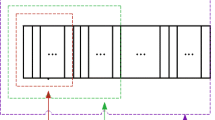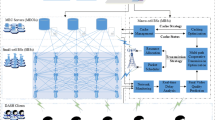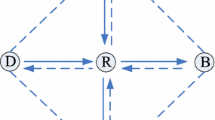Abstract
To provide multi-resolution video for heterogeneous users in wireless networks, Scalable Video Coding (SVC) encodes a video bit stream into one base layer and several enhancement layers, on the basis of their contribution in recovering the video correspondingly. However, a decoding dependency is introduced into these layers and artful operation is required for SVC streaming. Meanwhile, each SVC packet is associated with a hard time constraint so that users can recover their desired video quality timely. This paper focuses on the network coding assisted SVC multicast with hard deadline constraints. Specifically, we consider the cache-aware model where users are able to store all received packets and decode out the desired packets when sufficient packets are obtained. We analyze the effect of cached network coded packets on the SVC packets scheduling process and the video quality improvement, and value that effect through assigning proper weight for each packet. We also take multiple factors that affect quality of experience into consideration, such as channel condition, request’s deadline and user’s packets receiving status. Moreover, we adopt the instantly decodable network coding (IDNC) technique to schedule SVC packets. According to packets weighting on the vertices of a well-structured two-layered IDNC graph, an effective heuristic algorithm is proposed to schedule the most valuable SVC packets combinations within acceptable complexity. Extensive simulation results verify the effectiveness and the quality of experience enhancement accomplished by the proposed algorithm.









Similar content being viewed by others
Notes
The IDNC packet will be cached only if it contains lost packets of \(r_k\), and this information can be learnt from the header of the IDNC packet.
References
Medbo, J., Kyosti, P., Kusume, K., Raschkowski, L., Haneda, K., Jamsa, T., et al. (2016). Radio propagation modeling for 5G mobile and wireless communications. IEEE Communications Magazine, 54(6), 144–151.
Feng, H., Chen, Z., & Liu, H. (2018). Design and optimization of vod schemes with client caching in wireless multicast networks. IEEE Transactions on Vehicular Technology, 67(1), 765–780.
Cacciapuoti, A. S., Caleffi, M., Ji, M., Llorca, J., & Tulino, A. M. (2016). Speeding up future video distribution via channel-aware caching-aided coded multicast. IEEE Journal on Selected Areas in Communications, 34(8), 2207–2218.
Nayfeh, K. K., & Sarhan, N. J. (2016). A scalable solution for interactive near video-on-demand systems. IEEE Transactions on Circuits and Systems for Video Technology, 26(10), 1907–1916.
Wu, J., Cheng, B., Wang, M., & Chen, J. (2017). Energy-aware concurrent multipath transfer for real-time video streaming over heterogeneous wireless networks. IEEE Transactions on Circuits and Systems for Video Technology, 28, 2007–2023.
Wu, J., Cheng, B., & Wang, M. (2018). Improving multipath video transmission with raptor codes in heterogeneous wireless networks. IEEE Transactions on Multimedia, 20(2), 457–472.
Xiao, J., Tillo, T., & Zhao, Y. (2013). Real-time video streaming using randomized expanding reed solomon code. IEEE Transactions on Circuits and Systems for Video Technology, 23(11), 1825–1836.
Elgeldawy, F. A., Salama, G. M., & fattah, M. F. A. (2016). Performance of qos parameters for iptv through ngn. In 2016 IEEE Student Conference on Research and Development (SCOReD) (pp. 1–6).
Song, J., Yang, F., Zhou, Y., & Gao, S. (2016). Parametric planning model for video quality evaluation of iptv services combining channel and video characteristics. IEEE Transactions on Multimedia, 19, 1015–1029.
Qian, Y., Wei, X., Huang, R., Meng, H., & Liu, Q. (2016). Fault prediction in iptv using improved adaboost algorithm. In 2016 8th International conference on wireless communications signal processing (WCSP) (pp. 1–5).
Schwarz, H., Marpe, D., & Wiegand, T. (2007). Overview of the scalable video coding extension of the h.264/avc standard. IEEE Transactions on Circuits and Systems for Video Technology, 17(9), 1103–1120.
Seo, C. W., Han, J. K., & Nguyen, T. Q. (2011). Rate control scheme for consistent video quality in scalable video codec. IEEE Transactions on Image Processing, 20(8), 2166–2176.
HoangVan, X., Ascenso, J., & Pereira, F. (2016). Adaptive scalable video coding: A HEVC based framework combining the predictive and distributed paradigms. IEEE Transactions on Circuits and Systems for Video Technology, 27, 1761–1776.
Le, A., Tehrani, A., Dimakis, A., & Markopoulou, A. (2013). Instantly decodable network codes for real-time applications. In 2013 International symposium on network coding (NetCod) (pp. 1–6).
Aboutorab, N., Sadeghi, P., & Sorour, S. (2014). Enabling a tradeoff between completion time and decoding delay in instantly decodable network coded systems. IEEE Transactions on Communications, 62(4), 1296–1309.
Nguyen, H. D. T., Tran, L. N., & Hong, E. K. (2011). On transmission efficiency for wireless broadcast using network coding and fountain codes. IEEE Communications Letters, 15(5), 569–571.
Su, H., & Zhang, X. (2009). Modeling throughput gain of network coding in multi-channel multi-radio wireless ad hoc networks. IEEE Journal on Selected Areas in Communications, 27(5), 593–605.
Argyriou, A. (2009). Wireless network coding with improved opportunistic listening. IEEE Transactions on Wireless Communications, 8(4), 2014–2023.
Ahlswede, R., Cai, N., Li, S. Y. R., & Yeung, R. W. (2000). Network information flow. IEEE Transactions on Information Theory, 46(4), 1204–1216.
Li, S. Y. R., Yeung, R. W., & Cai, N. (2003). Linear network coding. IEEE Transactions on Information Theory, 49(2), 371–381.
Ho, T., Medard, M., Koetter, R., Karger, D. R., Effros, M., Shi, J., et al. (2006). A random linear network coding approach to multicast. IEEE Transactions on Information Theory, 52(10), 4413–4430.
Sorour, S., & Valaee, S. (2010). On minimizing broadcast completion delay for instantly decodable network coding. In 2010 IEEE International Conference on Communications (pp. 1–5).
Sorour, S., & Valaee, S. (2010). Minimum broadcast decoding delay for generalized instantly decodable network coding. In 2010 IEEE global telecommunications conference GLOBECOM 2010 (pp. 1–5).
Arefi, A., Khabbazian, M., Ardakani, M., & Bansal, G. (2018). Blind instantly decodable network codes for wireless broadcast of real-time multimedia. IEEE Transactions on Wireless Communications, 17(4), 2276–2288.
Douik, A., Sorour, S., Al-Naffouri, T. Y., & Alouini, M. S. (2017). Instantly decodable network coding: From centralized to device-to-device communications. IEEE Communications Surveys Tutorials, 19(2), 1201–1224.
Douik, A., Sorour, S., Al-Naffouri, T. Y., & Alouini, M. S. (2017). Rate aware instantly decodable network codes. IEEE Transactions on Wireless Communications, 16(2), 998–1011.
Rhaiem, O. B., Fourati, L. C., & Ajib, W. (2015). Qos improvement for video streaming over manet using network-coding. In 2015 IEEE 82nd vehicular technology conference (VTC Fall) (pp. 1–5).
Feng, D., & Gao, S. (2013). A wireless video transmission scheme based on network coding and scalable video coding. In 2013 7th International conference on signal processing and communication systems (ICSPCS) (pp. 1–6).
Zhou, H., Ji, Y., Gu, Y., & Zhao, B. (2012). Network coding based svc multicast over broadband wireless networks. In 2012 IEEE 37th conference on local computer networks (LCN) (pp. 428–435).
Halloush, M., & Radha, H. (2011). Network coding with multi-generation mixing for scalable and non-scalable video communication. In 2011 International conference on innovations in information technology (IIT) (pp. 398–403).
Tassi, A., Chatzigeorgiou, I., & Vukobratovic, D. (2015). Resource-allocation frameworks for network-coded layered multimedia multicast services. IEEE Journal on Selected Areas in Communications, 33(2), 141–155.
Chau, P., Kim, S., Lee, Y., & Shin, J. (2014). Hierarchical random linear network coding for multicast scalable video streaming. In Signal and information processing association annual summit and conference (APSIPA), 2014 Asia-Pacific (pp. 1–7).
Wang, S., Gong, C., Wang, X., & Liang, M. (2013). Instantly decodable network coding schemes for in-order progressive retransmission. IEEE Communications Letters, 17(6), 1069–1072.
Karim, M., Sadeghi, P., Aboutorab, N., & Sorour, S. (2015). In order packet delivery in instantly decodable network coded systems over wireless broadcast. In 2015 International symposium on network coding (NetCod) (pp. 11–15).
Li, H., Li, B., Tran, T. T., & Sicker, D. C. (2016). Transmission schemes for multicasting hard deadline constrained prioritized data in wireless multimedia streaming. IEEE Transactions on Wireless Communications, 15(3), 1631–1641.
Karim, M. S., Sadeghi, P., Sorour, S., & Aboutorab, N. (2016). Instantly decodable network coding for real-time scalable video broadcast over wireless networks. EURASIP Journal on Advances in Signal Processing, 2016, 3.
Zhan, C., & Xiao, F. (2016). Coding based wireless broadcast scheduling in real time applications. Journal of Network and Computer Applications, 64, 194–203.
Svc reference software [online]. available: Cvs server (host address: garcon.ient.rwthaachen.de).
Acknowledgements
This study was supported by the National Natural Science Foundation of China (Grant No. 61561029).
Author information
Authors and Affiliations
Corresponding author
Additional information
Publisher's Note
Springer Nature remains neutral with regard to jurisdictional claims in published maps and institutional affiliations.
Rights and permissions
About this article
Cite this article
Wang, S., Yan, C. & Yu, Z. Cache-Aware Network Coding-Based Scheduling for SVC Multicast in Wireless Networks with Hard Deadline Constraints. Wireless Pers Commun 111, 799–823 (2020). https://doi.org/10.1007/s11277-019-06885-y
Published:
Issue Date:
DOI: https://doi.org/10.1007/s11277-019-06885-y




